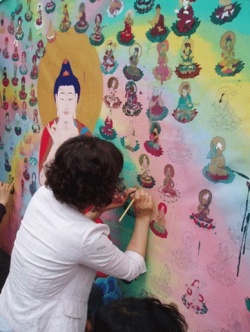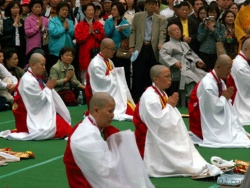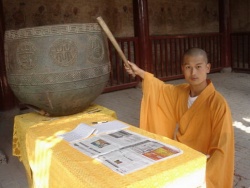Difference between revisions of "Cetana"
m (1 revision: Robo 2.48 15 septmeber replacetext) |
m (Text replacement - "[[[" to "([[") |
||
| (2 intermediate revisions by 2 users not shown) | |||
| Line 1: | Line 1: | ||
[[File:Lotus-lantern-fes.JPG|thumb|250px|]] | [[File:Lotus-lantern-fes.JPG|thumb|250px|]] | ||
| − | '''[[Cetanā]]''' ([[Sanskrit]], [[Pali]]; [[Tibetan]] Wylie: [[sems pa]]) is a [[Buddhist]] term commonly translated as "[[volition]]", "[[directionality]]", or "[[attraction]]". It can be defined as a [[mental factor]] that moves or [[urges]] the [[mind]] in a particular [[direction]], toward a specific [[object]] or goal. [[Cetanā]] is identified within the [[Buddhist teachings]] as follows: | + | '''[[Cetanā]]''' ([[Sanskrit]], [[Pali]]; [[Tibetan]] [[Wylie]]: [[sems pa]]) is a [[Buddhist]] term commonly translated as "[[volition]]", "[[directionality]]", or "[[attraction]]". It can be defined as a [[mental factor]] that moves or [[urges]] the [[mind]] in a particular [[direction]], toward a specific [[object]] or goal. [[Cetanā]] is identified within the [[Buddhist teachings]] as follows: |
* One of the seven [[universal]] [[mental]] factors in the [[Theravada]] [[Abhidharma]]. | * One of the seven [[universal]] [[mental]] factors in the [[Theravada]] [[Abhidharma]]. | ||
| Line 11: | Line 11: | ||
[[Bhikkhu Bodhi]] states: | [[Bhikkhu Bodhi]] states: | ||
[[File:14537-40.jpg|thumb|250px|]] | [[File:14537-40.jpg|thumb|250px|]] | ||
| − | : [[Cetana]]...is the [[mental factor]] that is concerned with the actualization of a goal, that is, the conative or {{Wiki|volitional}} aspect of {{Wiki|cognition}}. Thus it is rendered {{Wiki|volition}}. The Commentaries explain that [[cetana]] organizes its associated [[mental factors]] in [[acting]] upon the [[object]]. Its characteristic is the state of willing, its function is to accumulate ([[kamma]]), and its {{Wiki|manifestation}} is coordination. Its proximate [[cause]] is the associated states. Just as a chief pupil recites his own lesson and also makes the other pupils recite their own lessons, so when [[volition]] starts to work on its [[object]], it sets the associated states to do their tasks as well. [[Volition]] is the most significant [[mental]] factor in generating [[kamma]], since it is [[volition]] that determines the {{Wiki|ethical}} quality of the [[action]]. | + | : [[Cetana]]...is the [[mental factor]] that is concerned with the actualization of a goal, that is, the conative or {{Wiki|volitional}} aspect of {{Wiki|cognition}}. Thus it is rendered {{Wiki|volition}}. The Commentaries explain that [[cetana]] organizes its associated [[mental factors]] in [[acting]] upon the [[object]]. Its [[characteristic]] is the state of willing, its [[function]] is to [[accumulate]] ([[kamma]]), and its {{Wiki|manifestation}} is coordination. Its proximate [[cause]] is the associated states. Just as a chief pupil recites his own lesson and also makes the other pupils recite their own lessons, so when [[volition]] starts to work on its [[object]], it sets the associated states to do their tasks as well. [[Volition]] is the most significant [[mental]] factor in generating [[kamma]], since it is [[volition]] that determines the {{Wiki|ethical}} quality of the [[action]]. |
| − | The [[Atthasālinī]] (I, Part IV, Chapter I, 111) states that [[cetanā]] has the characteristic of coordinating the associated [[dhammas]] ([[citta]] and the other [[cetasikas]]) on the [[object]] and that its function is 'willing'. We read: | + | The [[Atthasālinī]] (I, Part IV, [[Chapter]] I, 111) states that [[cetanā]] has the [[characteristic]] of coordinating the associated [[dhammas]] ([[citta]] and the other [[cetasikas]]) on the [[object]] and that its [[function]] is 'willing'. We read: |
| − | : ...There is no such thing as {{Wiki|volition}} in the four planes of [[existence]] without the characteristic of coordinating; all {{Wiki|volition}} has it. But the function of 'willing' is only in {{Wiki|moral}} ([[kusala]]) and {{Wiki|immoral}} ([[akusala]]) states...It has directing as [[manifestation]]. It arises directing associated states, like the chief [[disciple]], the chief carpenter, etc. who fulfil their own and others' duties. | + | : ...There is no such thing as {{Wiki|volition}} in the four planes of [[existence]] without the [[characteristic]] of coordinating; all {{Wiki|volition}} has it. But the [[function]] of 'willing' is only in {{Wiki|moral}} ([[kusala]]) and {{Wiki|immoral}} ([[akusala]]) states...It has directing as [[manifestation]]. It arises directing associated states, like the chief [[disciple]], the chief {{Wiki|carpenter}}, etc. who fulfil their own and others' duties. |
===[[Mahayana]]=== | ===[[Mahayana]]=== | ||
| Line 21: | Line 21: | ||
The [[Abhidharma-samuccaya]] states: | The [[Abhidharma-samuccaya]] states: | ||
| − | : What is [[cetanā]]? It is a [[mental]] [[activity]] that propels the [[mind]] forward. It has the function of making the [[mind]] settle on what is positive, negative, or indeterminate. | + | : What is [[cetanā]]? It is a [[mental]] [[activity]] that propels the [[mind]] forward. It has the [[function]] of making the [[mind]] settle on what is positive, negative, or {{Wiki|indeterminate}}. |
{{Wiki|Herbert Guenther}} explains: | {{Wiki|Herbert Guenther}} explains: | ||
[[File:LotusLantern.JPG|thumb|250px|]] | [[File:LotusLantern.JPG|thumb|250px|]] | ||
| − | : It is a [[mental]] event that arouses and [[urges]] the [[mind]] with its corresponding events on towards an [[object]]. From among all [[mental]] events, it is said to be the most important because the force of this [[mental]] event sets the [[mind]] and any [[mental]] event on to the [[object]]. Just as iron cannot but be attracted by a magnet, so also the [[mind]] cannot be but set on an [[object]] by this [[mental]] event. | + | : It is a [[mental]] event that arouses and [[urges]] the [[mind]] with its corresponding events on towards an [[object]]. From among all [[mental]] events, it is said to be the most important because the force of this [[mental]] event sets the [[mind]] and any [[mental]] event on to the [[object]]. Just as {{Wiki|iron}} cannot but be attracted by a magnet, so also the [[mind]] cannot be but set on an [[object]] by this [[mental]] event. |
[[Alexander Berzin]] states: | [[Alexander Berzin]] states: | ||
| − | : An [[urge]] ([[sems-pa]]) [[causes]] the [[mental]] [[activity]] to face an [[object]] or to go in its [[direction]]. In general, it moves a [[mental]] {{Wiki|continuum}} to cognitively take an [[object]]. A [[mental]] {{Wiki|continuum}} (sems-rgyud, [[mind-stream]]) is an {{Wiki|individual}} everlasting sequence of moments of [[mental]] [[activity]]. | + | : An [[urge]] ([[sems-pa]]) [[causes]] the [[mental]] [[activity]] to face an [[object]] or to go in its [[direction]]. In general, it moves a [[mental]] {{Wiki|continuum}} to cognitively take an [[object]]. A [[mental]] {{Wiki|continuum}} ([[sems-rgyud]], [[mind-stream]]) is an {{Wiki|individual}} everlasting sequence of moments of [[mental]] [[activity]]. |
[[Mipham Rinpoche]] states: | [[Mipham Rinpoche]] states: | ||
[[File:14ages.jpg|thumb|250px|]] | [[File:14ages.jpg|thumb|250px|]] | ||
| − | : [[Cetana]] describes the process of [[mind]] | + | : [[Cetana]] describes the process of [[mind]] ([[attention]]) moving towards and becoming involved with an [[object]]. In terms of support, there are six, such as [[cetana]] upon meeting of the [[eye]] [i.e. between [[object]], [[sense]] {{Wiki|faculty}} and [[consciousness]]), and so forth. |
[[Cetanā]] operates with six supports, or along six channels: | [[Cetanā]] operates with six supports, or along six channels: | ||
| Line 44: | Line 44: | ||
# [[Cetanā]] occurring in [[thought]] situations | # [[Cetanā]] occurring in [[thought]] situations | ||
| − | ==Relation to [[karma]]== | + | ==[[Relation]] to [[karma]]== |
In the [[Buddhist]] [[tradition]], [[cetana]] is considered the most important [[mental factor]] in the generation of [[karma]]. | In the [[Buddhist]] [[tradition]], [[cetana]] is considered the most important [[mental factor]] in the generation of [[karma]]. | ||
| Line 54: | Line 54: | ||
[[Alexander Berzin]] explains (from the [[Mahayana]] point of [[view]]): | [[Alexander Berzin]] explains (from the [[Mahayana]] point of [[view]]): | ||
| − | : [According to [[Asanga]]'s] [[view]], [[karma]] (las) is a [[mental]] impulse. It is {{Wiki|synonymous}} with the [[mental]] factor of an [[urge]] ([[sems-pa]]). An [[urge]] is a [[mental factor]] that accompanies every moment of our [[experience]]. It is the [[mental factor]] that brings us in the [[direction]] of a particular [[experience]], either simply to look at or to listen to something, or, in this case, to do something with or to it, to say it, or to think it. Whether it is {{Wiki|physical}}, {{Wiki|verbal}}, or [[mental]] [[karma]], the [[karmic]] impulse is the [[mental factor]] of an [[urge]] to do, say, or think something. It is like the impulse to hit someone, to tell the [[truth]], or to think longing [[thoughts]] about a loved one. It is also the [[mental]] [[urge]] to continue doing, saying, or [[thinking]] something, as well as the [[mental]] [[urge]] to stop engaging in them and to do, say, or think about something else. Usually, we are not at all aware of these [[mental]] [[urges]] or impulses. In Western terminology, we would say they are usually "{{Wiki|unconscious}}." | + | : [According to [[Asanga]]'s] [[view]], [[karma]] (las) is a [[mental]] impulse. It is {{Wiki|synonymous}} with the [[mental]] factor of an [[urge]] ([[sems-pa]]). An [[urge]] is a [[mental factor]] that accompanies every moment of our [[experience]]. It is the [[mental factor]] that brings us in the [[direction]] of a particular [[experience]], either simply to look at or to listen to something, or, in this case, to do something with or to it, to say it, or to think it. Whether it is {{Wiki|physical}}, {{Wiki|verbal}}, or [[mental]] [[karma]], the [[karmic]] impulse is the [[mental factor]] of an [[urge]] to do, say, or think something. It is like the impulse to hit someone, to tell the [[truth]], or to think longing [[thoughts]] about a loved one. It is also the [[mental]] [[urge]] to continue doing, saying, or [[thinking]] something, as well as the [[mental]] [[urge]] to stop engaging in them and to do, say, or think about something else. Usually, we are not at all {{Wiki|aware}} of these [[mental]] [[urges]] or {{Wiki|impulses}}. In {{Wiki|Western}} {{Wiki|terminology}}, we would say they are usually "{{Wiki|unconscious}}." |
==Alternate translations== | ==Alternate translations== | ||
| − | * [[Attraction]] (Erik Pema Kunsang) | + | * [[Attraction]] ({{Wiki|Erik Pema Kunsang}}) |
* [[Directionality]] of [[mind]] ({{Wiki|Herbert Guenther}}) | * [[Directionality]] of [[mind]] ({{Wiki|Herbert Guenther}}) | ||
* [[Urge]] ([[Alexander Berzin]]) | * [[Urge]] ([[Alexander Berzin]]) | ||
Latest revision as of 04:36, 4 April 2016
Cetanā (Sanskrit, Pali; Tibetan Wylie: sems pa) is a Buddhist term commonly translated as "volition", "directionality", or "attraction". It can be defined as a mental factor that moves or urges the mind in a particular direction, toward a specific object or goal. Cetanā is identified within the Buddhist teachings as follows:
- One of the seven universal mental factors in the Theravada Abhidharma.
- One of the five universal mental factors in the Mahayana Abhidharma
- The most significant mental factor involved in the creation of karma.
Definitions
Theravada
Bhikkhu Bodhi states:
- Cetana...is the mental factor that is concerned with the actualization of a goal, that is, the conative or volitional aspect of cognition. Thus it is rendered volition. The Commentaries explain that cetana organizes its associated mental factors in acting upon the object. Its characteristic is the state of willing, its function is to accumulate (kamma), and its manifestation is coordination. Its proximate cause is the associated states. Just as a chief pupil recites his own lesson and also makes the other pupils recite their own lessons, so when volition starts to work on its object, it sets the associated states to do their tasks as well. Volition is the most significant mental factor in generating kamma, since it is volition that determines the ethical quality of the action.
The Atthasālinī (I, Part IV, Chapter I, 111) states that cetanā has the characteristic of coordinating the associated dhammas (citta and the other cetasikas) on the object and that its function is 'willing'. We read:
- ...There is no such thing as volition in the four planes of existence without the characteristic of coordinating; all volition has it. But the function of 'willing' is only in moral (kusala) and immoral (akusala) states...It has directing as manifestation. It arises directing associated states, like the chief disciple, the chief carpenter, etc. who fulfil their own and others' duties.
Mahayana
The Abhidharma-samuccaya states:
- What is cetanā? It is a mental activity that propels the mind forward. It has the function of making the mind settle on what is positive, negative, or indeterminate.
Herbert Guenther explains:
- It is a mental event that arouses and urges the mind with its corresponding events on towards an object. From among all mental events, it is said to be the most important because the force of this mental event sets the mind and any mental event on to the object. Just as iron cannot but be attracted by a magnet, so also the mind cannot be but set on an object by this mental event.
Alexander Berzin states:
- An urge (sems-pa) causes the mental activity to face an object or to go in its direction. In general, it moves a mental continuum to cognitively take an object. A mental continuum (sems-rgyud, mind-stream) is an individual everlasting sequence of moments of mental activity.
Mipham Rinpoche states:
- Cetana describes the process of mind (attention) moving towards and becoming involved with an object. In terms of support, there are six, such as cetana upon meeting of the eye [i.e. between object, sense faculty and consciousness), and so forth.
Cetanā operates with six supports, or along six channels:
- Cetanā occurring in visual situations
- Cetanā occurring in auditory situations
- Cetanā occurring in olfactory situations
- Cetanā occurring in gustatory situations
- Cetanā occurring in tactile situations
- Cetanā occurring in thought situations
Relation to karma
In the Buddhist tradition, cetana is considered the most important mental factor in the generation of karma.
Bhikkhu Bodhi states (from the Theravada point of view):
- Volition is the most significant mental factor in generating kamma, since it is volition that determines the ethical quality of the action.
Alexander Berzin explains (from the Mahayana point of view):
- [According to Asanga's] view, karma (las) is a mental impulse. It is synonymous with the mental factor of an urge (sems-pa). An urge is a mental factor that accompanies every moment of our experience. It is the mental factor that brings us in the direction of a particular experience, either simply to look at or to listen to something, or, in this case, to do something with or to it, to say it, or to think it. Whether it is physical, verbal, or mental karma, the karmic impulse is the mental factor of an urge to do, say, or think something. It is like the impulse to hit someone, to tell the truth, or to think longing thoughts about a loved one. It is also the mental urge to continue doing, saying, or thinking something, as well as the mental urge to stop engaging in them and to do, say, or think about something else. Usually, we are not at all aware of these mental urges or impulses. In Western terminology, we would say they are usually "unconscious."
Alternate translations
- Attraction (Erik Pema Kunsang)
- Directionality of mind (Herbert Guenther)
- Urge (Alexander Berzin)
- Volition (Bikkhu Bodhi)




